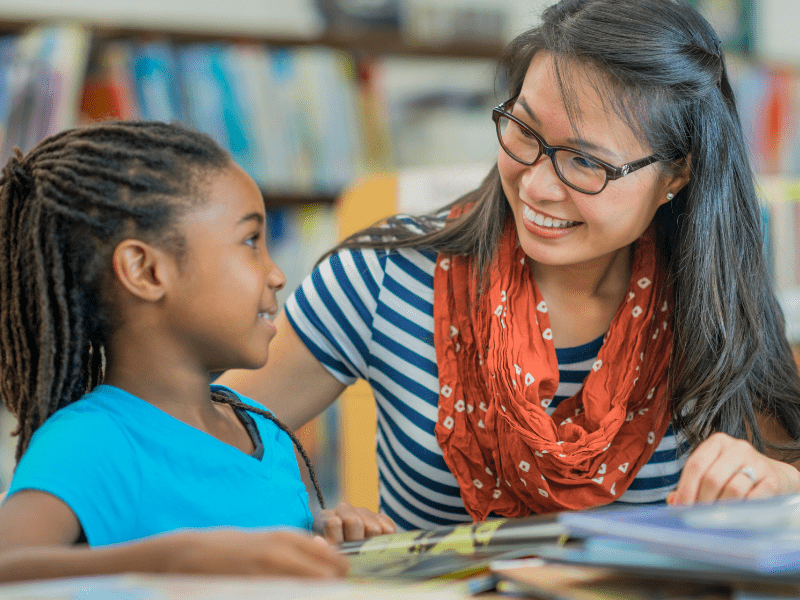Structured Literacy And Dyslexia
What is Dyslexia?
- Dyslexia is a specific learning disability that is neurobiological in origin. It is characterized by difficulties with accurate and/or fluent word recognition and by poor spelling and decoding abilities. These difficulties typically result from a deficit in the phonological component of language that is often unexpected in relation to other cognitive abilities and the provision of effective classroom instruction. Secondary consequences may include problems in reading comprehension and reduced reading experience that can impede growth of vocabulary and background knowledge.
- Adopted by the IDA Board of Directors, Nov. 12, 2002. Many state education codes, including New Jersey, Ohio and Utah, have adopted this definition. Learn more about how consensus was reached on this definition: Definition Consensus Project.
Hurley, Kelli Sandman What is dyslexia? YouTube Jul 15, 2013, https://www.youtube.com/watch?v=zafiGBrFkRM

Dyslexia Description
- Reading is complex. It requires our brains to connect letters to sounds, put those sounds in the right order, and pull the words together into sentences and paragraphs we can read and comprehend.
- People with dyslexia have trouble matching the letters they see on the page with the sounds those letters and combinations of letters make. And when they have trouble with that step, all the other steps are harder.
- Dyslexic children and adults struggle to read fluently, spell words correctly and learn a second language, among other challenges. But these difficulties have no connection to their overall intelligence. In fact, dyslexia is an unexpected difficulty in reading in an individual who has the intelligence to be a much better reader. While people with dyslexia are slow readers, they often, paradoxically, are very fast and creative thinkers with strong reasoning abilities.
- Dyslexia is also very common, affecting 20 percent of the population and representing 80– 90 percent of all those with learning disabilities. Scientific research shows differences in brain connectivity between dyslexic and typical reading children, providing a neurological basis for why reading fluently is a struggle for those with dyslexia.
- Dyslexia can’t be “cured” – it is lifelong. But with the right supports, dyslexic individuals can become highly successful students and adults.
Characteristics of Dyslexia
The Preschool Years
- Delayed spoken language
- Trouble learning songs and nursery rhymes
- Difficulty learning (and remembering) names of letters
- Mispronounces familiar words; persistent “baby talk”
- Doesn’t recognize letters in own name
- Unable to create or recognize rhyming patterns like cat, bat, rat
- Family history of reading and/or spelling difficulties (dyslexia often runs in families)

Elementary, Middle & High School

Reading
- Slow in acquiring reading skills; reading is slow and awkward period here?
- Cannot sound out simple words like cat, map, nap
- Reading errrors that show no connections to letter sounds, such as reading “kitty” instead of “cat” when there is a picture of a cat
- Able to read, but it is labored, and it takes a long time
- Little awareness of sounds in words, sound order, rhymes, or sequence of syllables
- Lacks a strategy for reading new words, often guesses based on first or last letters
Problems with reading comprehension - Complains about how hard reading is; “disappears” when it is time to read
- History of reading problems in parents, siblings, or extended family
Spelling and Writing
- Repeated spelling errors
- Studies for a spelling test, but cannot retain the words the following week
- Difficulty expressing thoughts in written form despite creative ideas or strong understanding of topic
- Handwriting that is slow, messy, or awkward
- Takes a very long time to handwrite, even when copying


Speech
- Has trouble expressing thoughts orally
- Difficulty in finding the “right” word; searches for a specific word and ends up using vague language, such as “stuff” or “thing”
- Pauses, hesitates, and/or uses lots of “um’s” when speaking
- Confuses words that sound alike, such as saying “tornado” for “volcano,” substituting “lotion” for “ocean”
- Imprecise or incomplete interpretation of language that is heard
Math
- Difficulties in mathematical calculations
- Hard time with language in math; cannot read word problems
- Cannot memorize simple things like basic math facts, addresses, and phone numbers


The Preschool Years
- Struggles with low self-esteem, anxiety, embarrassment
- Uncertainty as to right- or left-handedness; confuses left and right
- Difficulty with organization
- Confusion about directions in space or time (right & left, up & down, early & late, yesterday & tomorrow, months & days)
- Took a long time to learn to tie shoes or can’t yet
- Dislike or avoidance of school
Young Adult And Adult
Reading
- Childhood history of reading and spelling difficulties
- While reading skills have developed over time, reading still requires great effort and is done at a slow pace
- Rarely reads for pleasure
- Slow and inaccurate reading of most materials—books, manuals, subtitles in films
- Avoids reading aloud


Speaking
- Earlier speech difficulties persist, including a lack of fluency; frequent use of “um’s” and imprecise language; anxiety when speaking
- Often pronounces the names of people and places incorrectly; trips over parts of words
- Difficulty remembering names of people and places; confuses names that sound alike
- Struggles to retrieve words; frequently has “It was on the tip of my tongue” moments
- Rarely has a fast response in conversations; struggles when put on the spot
- Spoken vocabulary is smaller than listening vocabulary
- Avoids saying words that might be mispronounced
School & Life
- Difficulty taking tests
- Penalized for spelling errors
- Frequently sacrifices social life for studying
- Suffers extreme fatigue when studying or reading
- Performs rote clerical tasks poorly
- Despite good grades or career success, feels dumb or is concerned that peers think they’re dumb
- Poor self-esteem, shame

Dyslexia Strengths

- Eager embrace of new ideas; curiosity
- Great imagination
- Good understanding of new concepts
- Excellent comprehension of stories read or told to them
- Ability to understand the “big picture”; gets the gist of things
- Creative problems solving skills; thinks outside the box
- Excellent thinking skills: conceptualization, reasoning, imagination, abstraction
- Success in areas not depending on reading (i.e., STEM, arts, computers)
- Noticeable improvement when given additional time
- Good writing skills if spelling isn’t counted
- Success in areas not dependent on rote memory
- Exceptional empathy and warmth
- Hard workers
What Dyslexia is Not
- Dyslexia is not caused by laziness or lack of effort; dyslexics work as hard or harder than non-dyslexic peers, often with worse results
- Dyslexia is not seeing or reading backward; dyslexia is unrelated to vision
- Dyslexia is not caused by a lack of focus; ADHD (Attention Deficit Hyperactivity Disorder) may be present, but is not the cause
- Dyslexia is not a disease, so it has no cure; its effects can be diminished with Structured Literacy Instruction
- Dyslexia is not a result of low intelligence; it is a difficulty with language skills, not thinking skills
- Dyslexia is not caused by poverty or lack of educational opportunity
- Dyslexia is not caused by laziness, inattention, poor vision, low intelligence, or social/emotional problems. However, the frustration of failing to learn basic skills can cause emotional problems
- ADHD (Attention deficit hyperactive disorder) may be present, but it does not cause dyslexia
- It is a myth that individuals with dyslexia read or see “backward”; dyslexia is not a vision problem
- The difficulty with reading and spelling is not because they are not trying hard enough
- Dyslexia is not a disease, and therefore there is no cure
- Individuals with dyslexia do not have a lower level of intelligence

Dyslexia Strengths
The Michigan Dyslexia Handbook is designed to help educators and district and school leaders develop a shared understanding of best practices to prevent reading difficulties associated with the primary consequences of dyslexia (word-level reading disability) and to implement assessment practices needed to inform the instruction and intervention methods for learners with dyslexia characteristics.
Structured Literacy And Dyslexia

What is Structured Literacy?
At IDA we believe that teaching practices must be grounded in scientific, peer-reviewed research. Structured Literacy is an evidence-based instructional approach that emphasizes all components of literacy. This includes phonemic awareness, decoding, spelling, reading comprehension, and written expression. It is effective for all individuals learning to read, but it is essential for those with dyslexia.
Key Elements of Structured Literacy
Many popular reading approaches, such as Whole Language and Balanced Literacy, are ineffective for struggling readers. What does work is Structured Literacy, which prepares students to decode words in an explicit and systematic manner. Structured Literacy is more effective for all readers, not just those with dyslexia.
Key Elements of Structured Literacy
The most difficult problem for students with dyslexia is learning to read. Unfortunately, popularly employed reading approaches, such as Guided Reading or Balanced Literacy, are not effective for struggling readers. These approaches are especially ineffective for students with dyslexia because they do not focus on the decoding skills these students need to succeed in reading.
What does work is Structured Literacy, which prepares students to decode words in an explicit and systematic manner. This approach not only helps students with dyslexia. There is substantial evidence that it is more effective for all readers. Continue reading for a description of each component of Structured Literacy.
Phonology
Phonology is the study of the sound structure of spoken words. Phonemic Awareness, an essential element of Structured Literacy, is the ability to identify and manipulate individual sounds (phonemes) in spoken words. A phoneme is the smallest unit of sound that can be recognized as being distinct from other sounds in the language. Activities that promote phonemic awareness include rhyming, tapping phonemes, clapping syllables, and deleting or changing sounds.Strong phonemic awareness is a good predictor of reading success.
- Study of spoken words
- Includes Phonemic Awareness, the ability to identify and manipulate sounds in spoken words
- Rhyming, tapping sounds, and clapping syllables build phonemic awareness
- Strong phonemic awareness is a predictor of reading success
Sound-Symbol Association
Sound-Symbol Association, often called phonics, is the ability to identify a letter name and symbol(s) with a specific phoneme or sound. It must be taught and mastered in two directions: visual to auditory (reading) and auditory to visual (spelling). Students must master the blending of sounds and letters into words and the segmenting of whole words into individual sounds.
- Ability to identify a letter name, sounds and symbols
- Also called Phonics
- In reading, symbols are converted to sounds
- Students learn to blend sounds and letters into words
- In spelling, sounds are converted to symbols
- Students learn to segment words into sounds
Syllable Instruction
A syllable is a unit of language with one vowel sound. By knowing the syllable type, the reader can determine the sound of the vowel in the syllable. Syllable division rules allow readers to decode long, unfamiliar words by chunking them into smaller pieces. The six syllable types are:
- Closed: spelled with a single vowel ending in one or more consonants. Vowel sound is short. Examples: kid, candle
- Open: ends with a long vowel sound spelled with a single vowel letter. Examples: we, begin
- Vowel-Consonant-e (Silent e): spelled with one vowel + one consonant + silent e. Examples: line, exhale
- Vowel Team: includes 2-4 letters representing a long, short, or dipthong vowel sound. Examples: spoil, auto, trainer
- Vowel-R: syllable with er, ir, or, ar, or ur. Vowel pronunciation often changes before /r/. Examples: fur, car, perform, further
- Consonant-le: unaccented final syllable that contains a consonant before /l/, followed by a silent e. Examples: little, bundle
- A syllable is a unit of language with one vowel sound
- By knowing the syllable type, the reader can determine the sound of the vowel in the syllable
- Syllable division rules allow readers to decode long, unfamiliar words by chunking them into smaller pieces
Syllable Types
|
Type |
Description |
Vowel Sound |
Examples |
|
Closed |
single vowel ending in consonant |
short sound |
kid, basket |
|
Open |
ends with a vowel |
long |
we, begin, why |
|
Vowel-Cons-E |
vowel+cons+e |
long |
line, exhale |
|
Vowel Team |
2 or more vowels together |
short or long |
train, boat, pie, tree |
|
Dipthong |
2 vowels make unique sound |
unique |
auto, spoil, straw |
|
Vowel-R |
vowel+R |
changes depending on vowel |
fur, car, ornate |
|
Consonant-LE |
consonant+le |
none |
little, bundle |
Morphology
A morpheme is the smallest unit of meaning in the language. The Structured Literacy curriculum includes the study of base words, roots, prefixes, and suffixes. The word instructor, for example, contains the root struct, which means to build or teach, the prefix in, which means in or into, and the suffix or, which means one who. An instructor is one who builds knowledge in their students.
- A morpheme is the smallest unit of meaning in language
- Study of base words, roots, prefixes, and suffixes
- Example: “instructor” contains root struct, prefix in, suffix or
- Based on word meanings, not word sounds
Syntax
Syntax is the set of principles that dictate the sequence and function of words in a sentence. This includes grammar, sentence structure, language mechanics, and punctuation. Syntax delinieates a specific order for grammatical elements like subjects, verbs, and direct objects. Consider the following sentences:
- She enjoys cooking her family and her dog.
- She enjoys cooking, her family, and her dog.
One type of syntax error is incorrect comma usage, which can affect meaning.
- Principles that dictate sequence and function of words in a sentence
- Includes grammar, sentence structure, language mechanics, and punctuation
- Delineates specific order for grammatical elements like subjects, verbs, and direct objects
Semantics
Semantics is the study of words, sentences and phrases and their meaning. Many words have similar meanings and it is important to distinguish their subtle differences. For example, “anger” and “rage” are similar in meaning, but “rage” implies a stronger reaction.
- Study of words, phrases, sentences, and their meaning
- Includes subtle differences between meanings in similar words
- Examples: anger v. rage, sympathy v. empathy
- Incorporates literal v. symbolic meanings
Instructional Methods for Structured Literacy
Systematic and Cumulative
Structured Literacy instruction is systematic and cumulative. Systematic means that the organization of material follows the logical order of the language. The sequence must begin with the easiest and most basic concepts and elements and progress methodically to more difficult concepts and elements. Cumulative means each step must be based on concepts previously learned.
- Organization of material follows the logical order of language
- Progresses from basic to more complicated concepts
- Each step based on concepts previously learned
- Materials contain previously learned reading and spelling patterns
Explicit Instruction
Structured Literacy instruction requires the deliberate teaching of all concepts with continuous student-teacher interaction. It is not assumed that students will naturally deduce these concepts on their own.
- Deliberate teaching of all concepts in a logical order
- Continuous student-teacher interaction
- No assumption that students will naturally deduce new concepts
Diagnostic Teaching
The teacher must be adept at individualized instruction. The instruction is based on careful and continuous assessment, both informally (e.g., observation) and formally (e.g., standardized tests). The content presented must be mastered to the degree of automaticity. When students decode words automatically, it allows them attend to comprehension and fluency.
- Individualized instruction based on careful and continuous assessment
- Includes informal (observation) and formal (standardized tests) assessment
- The content must be mastered to the degree of automaticity
- Automaticity allows students to attain comprehension and fluency
Balanced Literacy vs Structured Literacy
What is Balanced Literacy?
At MI-IDA our goal is for every classroom in the state to use literacy instruction proven by research to be effective at teaching all students to read and write. Sadly, literacy testing suggests this is not the case. As reported by Michigan.gov, Michigan is facing a literacy crisis. As of 2017, 64% of fourth graders were at or below basic reading levels and just 27% were proficient readers.
What is Balanced Literacy?
A crucial cause of this crisis is the use of Balanced Literacy, an approach focusing on activities that surround children with quality literature and promote a love of reading. While this is an admirable goal, Balanced Literacy lacks the explicit, systematic, sequential instruction required for accurate decoding. Read more about the effectiveness of Structured Literacy over Balanced Literacy in this article from the Iowa Reading Research Center.

Balanced Literacy and Structured Literacy
Structured Literacy
Phonics skills taught explicitly and systematically, with
prerequisite skills taught first.
Part to whole phonics approach: students learn letter sounds and patterns and how to blend them.
Beginning readers read decodable texts, which are controlled to specific phonics patterns that have been explicitly taught. This allows students to use phonics skills in books.
Oral text reading with a teacher is included in lessons.
When reading orally, students encouraged to apply decoding skills, such as letter sounds and syllabication, when reading unfamiliar words.
Spelling skills taught explicitly and systematically with prerequisite skills taught first. Instruction reinforces reading skills.
Higher levels of literacy such as sentence structure and paragraph writing are explicitly and systematically taught.
Balanced Literacy
Phonics taught but not emphasized. Teaching may not be explicit or systematic.
May include phonics, but is often whole to part with less examination of sounds and patterns.
Beginning readers usually read leveled and predictable texts, in which words can be guessed based on sentence structure, repetition, or pictures. Text not controlled for previously learned phonics skills.
Partner and independent reading often emphasized more than oral reading.
When students read orally, errors not affecting meaning may be overlooked. Error correction may emphasize sentence context or pictures rather than spelling and pronunciation.
Spelling often not taught explicitly or systematically. Words may not exemplify particular phonics patterns or rules. Spelling program may not reinforce reading program.
Higher literacy skills may be explicitly taught but
often not systematically or with attention to prerequisite skills.
Why is Balanced Literacy Ineffective?
- It is not supported by peer-reviewed, scientific research. Research has shown that exposure to unfamiliar words without appropriate decoding instruction will lead to use of compensatory strategies, such as relying on pictures. Creating cozy reading areas and giving kids books by award-winning authors is wonderful, but ineffective if they aren’t receiving comprehensive in how to read.
- It promotes guessing. One of the pillars of Balanced Literacy is the three-cueing system, which encourages students to conjecture words using semantic, syntactic, and visual cues. Here is an example:
- In the sentence, “My favorite farm animal is a donkey,” the student struggles to read “donkey.”
- The teacher asks questions such as
- What animals start with d?
- Would “dog” make sense in this sentence?
- Is “dog” always a farm animal?
- What animal do you see in the picture?
- Student says “donkey,” but is not reading it using letter sounds and syllable patterns. Therefore, they won’t be able to read it in isolation.
- Multiple studies have proven that skilled readers rely primarily on a word’s spelling and pronunciation rather than syntactic and semantic cues, yet it is still widely used.
- The chart below highlights some of the “strategies” promoted by Balanced Literacy. Note that “Lips the Fish” and “Chunky Monkey” are the only two that encourage use of letter-sound correspondence, but are only used for part of the word.
INEFFECTIVE ways to figure out an unknown word when reading. These strategies are taught in a whole language/balanced literacy approach.


The Purple Challenge
In the following videos, parent and behavioral scientist Esti Iturralde conducts experiments with her first grader to show that phonics instruction, not Balanced Literacy, leads to strong decoding skills.
Sold a Story: How Teaching Kids to Read Went So Wrong
Wondering how an ineffective strategy for reading instruction became so widely used? Listen to this podcast from Emily Hanford and American Public Media for the full story.
